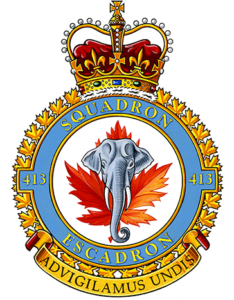 No. 413 Squadron
No. 413 Squadron
Badge: In front of a maple leaf an elephant’s head affronte
Motto: Ad vigilamus undis (We watch the waves)
Authority: King George VI, October 1943
The elephant head represents the squadron’s operations from Ceylon, while the motto suggests its functions.
Unofficially formed as No. 13 (Photographic) Squadron at Rockcliffe (Ottawa), Ontario on 20 May 1944, and officially renumbered as No. 413 Squadron on 1 April 1947, (1) the unit flew Mitchell and Lancaster aircraft on aerial photography. On 1 April 1949 it was redesignated Survey Transport and flew Dakota, Canso and Norseman aircraft in logistical support and the transportation of survey parties in the far north. The squadron was disbanded on 1 November 1950.
Brief Chronology: Unofficially formed as No. 13 (P) Sqn, Rockcliffe, Ont 20 May 44. Renumbered No. 413 (P) Sqn 1 Apr 47. Redesignated No. 413 (ST) Sqn 1 Apr 49. Disbanded 1 Nov 50.
Nickname: “Tusker”
Commanders
- S/L J.A. Wiseman, AFC 1 Apr 47 – 4 Jan 48.
- S/L C. S. Olsen, CD 5 Jan 48 – 24 Aug 49.
- W/C AP. Blackburn, DFC 25 Apr 49 – 22 Jan so.
- W/C D.J.G. Jackson 3 Jan 50 – 1 Nov 50.
Higher Formations and Squadron Location
Air Transport Command:
No. 22 (Photographic) Wing,
- Rockcliffe, Ont. 1 Apr 47 – 1 Nov 50.
Representative Aircraft (Unit Code AP)
Noorduyn Norseman Mk. VI (Apr 47 – Oct 50)
- 371 AP-N 787 AP-P 2495 AP-P 2496 AP-Q
Consolidated Canso A (Apr 47 – Oct 50)
- 11003 AP-K 11018 AP-J 11047 AP-W 11075 AP-K 11079 AP-M
North American Mitchell Mk.II (Apr 47 – Oct 48)
- KL145 891 892 894
Avro Lancaster Mk.X (Jan – Apr 48)
- FM207 FM212 AP-A FM216 AP-O FM218 AP-U
Douglas Dakota Mk.IV (Apr 49 – Oct 50)
- KN427 AP-R 635
Honours and Awards: 2 AFC’s (2), 1 King’s Commendation (3).
(1) See No. 13 Squadron for details
(2) Awarded to F/L J.F. Drake and F/O J.E. Goldsmith for their part in Operation “Polco,” the locating of the North Magnetic Pole, in July 1950.
(3) To Sgt A.B. Hillman for his work in Operation “Palco.”
Formed as a Fighter unit at Bagotville, Quebec on 1 August 1951 with Vampire and Sabre aircraft, the squadron joined No. 3 (Fighter) Wing as Zweibrucken, Germany in April 1953. In 1956, it was decided to replace one Sabre squadron in each of No. 1 Air Division Europe’s four wings with an all-weather fighter unit. When No. 440 AW(F) Squadron arrived from Canada, No. 413 was deactivated on 7 April 1957 and reactivated as All-Weather (Fighter) at Bagotville on 1 May. The squadron flew CF-100 aircraft on North American air defense until disbanded on 30 December 1961 (1).
Brief Chronology: Formed as No. 413 (F) Sqn, Bagotville, Que. 1 Aug 51 (2). Deactivated at Zweibrucken, Ger, 7 Apr 57. Reactivated as No. 413 AW(F) Sqn, Bagotville, Que. 1 May 57. Disbanded 30 Dec 61.
Nickname: “Tusker”
Commanders
- S/L J.D. Lindsay, DFC 1 Aug 51 – 6 Mar 53.
- S/L W.I. Gordon 7 Mar 53 – 1 Sep 53.
- S/L E.P. Wood, DFC 8 Jun 54 – 10 Jul 50.
- W/C H.C. Stewart, AFC, CD 27 Aug 56 – 7 Apr 57.
Squadron inactive
- S/L C. Allison, CD 1 Jul 57 – 14 Jul 59.
- W/C J.R.D. Schultz, DFC and Bar, CD 24 Aug 59 – 20 Aug 60.
- S/L E.G. Smith, DFC, CD 21 Aug 60 – 28 Jan 61.
- W/C E.D. Kelly, CD 2 Feb 61 – 30 Dec 61.
Higher Formations and Squadron Locations
Air Defence Command:
- Bagotville, Que. 1 Aug 51 – 6 Mar 53.
- En route overseas (Operation “Leapfrog Ill”) 7 Mar 53 – 6 Apr 53.
No. 1 Air Division Europe:
No. 3 (Fighter) Wing,
- Zweibrucken, Ger. 7 Apr 53 – 7 Apr 57.
Squadron inactive
North American Air Defence Command,
RCAF Air Defence Command:
- Bagotville, Que. 1 May 57 – 30 Dec 61.
Representative Aircraft (Unit Code AP)
de Havilland Vampire Mk.Ill (Aug – Dec 51)
Canadair Sabre Mk.2 (Nov 51 – Jun 54)
- 19213 19222 19236 19242
Canadair Sabre Mk.5 (Jun 54 – Sep 55)
- 23083 23145 23155 23180
Canadair Sabre Mk.6 (Sep 55 – Apr 57)
Avro CF-100 Canuck Mk.5 (May 57 – Dec 61)
- 18519 18640 18668
(1) In its 18 years and 7 months of active service, the squadron had the distinction of being the first RCAF squadron to have operated on every continent except South America.
(2) Originally to have been formed as an all-weather fighter unit, but the order was amended on 8 November 1951 to day fighter.








